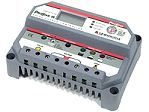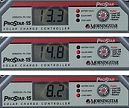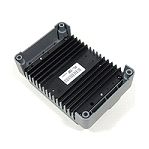DIY Solar-Powered PC: Solar Components
Charge Controller: Battery Stores Excess Solar Energy
To make sue our PC and monitor always have sufficient power, we must use a charge controller. This device directs excess energy that the PC doesn't use into a storage battery. The stored energy from the battery is used when bad weather hampers power collection, or during night-time hours when no power is collected at all.
Morningstar ProStar-15 charge controller
We used the ProStar-15 solar charge controller, made available to us by the German company, Wagner Solar. As the product name is meant to indicate, it can load a battery with a maximum current of 15 Amperes. This entails around 190 Watts. Because our solar generator can deliver a maximum of 260 Watts, this leaves about 70 Watts left over. At idle, our solar-powered PC consumes about 61 Watts, which makes our 15 Amp charge controller and ideal fit for our setup. The energy output from the charge controller goes primarily to service the PC.
This device can also display the actual battery voltage, power delivered from the solar panels, or energy consumed by the computer, as the following photos attest.
Readings for battery voltage (top), solar amperage (middle), and load amperage (bottom).
The solar charge controller obtains its power from the battery, because when it's dark there would otherwise be no power available for its use (and no possibility of controller charge and discharge behavior). Because power regulation also entails energy loss, the rear side of the charge controller is bedecked with a heatsink, to dissipate related heat production.
Rear view of the charge controller
Get Tom's Hardware's best news and in-depth reviews, straight to your inbox.
Current page: Charge Controller: Battery Stores Excess Solar Energy
Prev Page Modular Junctions For Maximal Cabling, Continued Next Page 1.5 KWh Storage Battery

